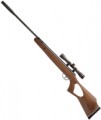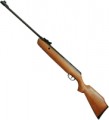Sighting device
The type of sighting device that the rifle is initially equipped with. Note that many models allow the installation of other sights - in addition to the standard sighting devices or to replace them. And optics or a collimator can initially be combined with a mechanical sight (front sight + rear sight), which in such cases plays the role of a spare. However, these features are not available in every rifle, so when choosing, it is best to focus on the type of complete sight.
Nowadays, in addition to the traditional
sighting bar with a front sight, you can find diopter,
optical and
collimator sights in air rifles, and in some models, standard sighting devices are completely
absent. Here are the features of each of these options:
— Sighting bar and front sight. Devices in the form of a front sight and a rear sight, which looks like a horizontal bar with a slot; when aiming, you need to combine these devices so that the front sight is visible exactly in the middle of the slot and flush with its edges. Such sights are extremely popular in modern pneumatics: they are extremely simple, inexpensive, compact and reliable, and do not depend on batteries and are quite resistant to impacts and vibrations. In addition, the front sight with a bar does not limit the view as much as optics or a collimator, and is better suited for shoo
...ting at moving targets. The main disadvantage of this option is that a certain skill is required for effective aiming - after all, you need to control not only the aiming at the target, but also the relative position of the front sight and the slot. On the other hand, this point can also be an advantage - in particular, when learning to shoot: having learned to shoot effectively with such devices, the shooter will feel quite confident with other types of sights. It is also worth noting that the front sight and rear sight do not provide any magnification - this makes it difficult to shoot at small and / or distant targets; however, again, this feature is not always an unambiguous disadvantage.
— Diopter sight. A type of mechanical sighting device (i.e. front sight and rear sight) that uses the diopter principle of operation. The rear sight in such devices is a plate with a small hole through which the shooter looks at the front sight. Such a rear sight is easier to use than a traditional bar with a slot, especially for beginners: even without special skills, the shooter subconsciously chooses a position of the eye in which the front sight will be in the center of the hole (as it should be when aiming). In addition, a small hole gives a slight magnification effect and increases the clarity of the target contours, which is especially important at significant distances. On the other hand, diopters significantly limit the view, are poorly suited for low-light conditions and are easily clogged with various contaminants. Therefore, this type of sight is extremely rarely used in airguns - mainly in powerful long-range rifles, primarily for sporting purposes.
— Optical sight. Traditional optical sights in the form of a "spyglass" with a reticle applied to the shooter's field of view. Initially created for high-precision shooting at long distances, mainly at stationary targets; pneumatics are also used in the same role. True, not every pneumatic rifle with optics is a powerful long-range weapon - there are also relatively "weak" models. But even such pneumatics can be a good training aid in high-precision shooting: a short distance in this case can be compensated for by the small size of the target. On the other hand, optics significantly affect the price of the rifle and require careful handling. Of its features, it is also worth noting that such sights necessarily have a certain magnification; due to this, they allow you to better examine small targets, but at the same time limit the field of view. It is also necessary to take into account that the optics are not well suited for off-hand shooting and require careful insertion: the eye must be located exactly on the optical axis of the sight, otherwise the aiming point may not coincide with the point of impact.
— Collimator sight. The working part of a collimator sight is a glass window onto which a luminous aiming mark is projected using a special optical system — a dot, crosshair, circle with a dot, etc. Sights of this type usually do not have magnification and are intended for shooting at short distances, including at moving targets and offhand. So in use, a collimator is similar to a front sight with a rear sight; and its key advantage is its ease of use: there is no need to combine the front sight and the notch, it is enough to find the aiming mark in the window and point it at the target. At the same time, unlike optics, it is not necessary to keep your eye strictly opposite the center of the sight: the parallax effect (see "Adjusting the parallax") in collimators is very weakly expressed, or even absent altogether. The main disadvantage of this type of sight is that they require batteries to operate; In addition, collimators are significantly more expensive than traditional mechanical sights and also require more careful handling (although they are still less delicate than optics).
It is worth noting that such devices are especially popular in airsoft airguns, such as most AEGs (see "Type"): collimators are great for dynamic combat.
— None. The absence of any sighting devices in the original delivery set — there are only mounts for installing such devices. For more information on the different types of mounts, see below; here we note that such a complete set does not allow you to use the rifle "out of the box", but it does give you the opportunity to choose a sight for it at your own discretion, without relying on the manufacturer's choice. This is especially important if you plan to use optics — nowadays a wide variety of such sights are produced for different tasks and scenarios of use. In fact, most air rifles without a sight are designed specifically for installing optics, although the use of collimators is often also allowed; and in airsoft pneumatics, removable front sights with rear sights are also used.
It is worth noting that spring-piston rifles and gas piston models have a specific double recoil that not every scope can withstand - even if it allows use with powerful firearms. So when looking for optics or a collimator for such pneumatics, you should be especially careful - for it you need to choose scopes originally designed for such rifles.Magnification
The degree of magnification provided by the rifle's complete optical sight; for models with variable magnification, the entire adjustment range is indicated, for example 3 – 9x.
For sights of this type in general, see "Aiming Device". And several points depend on the degree of increase at once. On the one hand, a higher magnification allows you to better see small and/or distant targets and facilitates high-precision shooting; on the other hand, it limits the angle of view and significantly affects the cost of the sight, and sometimes also its dimensions and weight. And since air rifles are mostly not designed for long distances, the magnification of complete optics in them usually does not exceed 9x, and one of the most popular options is 4x. However, there are exceptions: in powerful high-end pneumatics, you can find sights with a maximum magnification of 24x and even higher.
Actually, the manufacturer most often selects the magnification of optics for the ballistic characteristics of the rifle. So, when choosing this parameter, it often turns out to be secondary, and it makes sense to focus primarily on the muzzle velocity of the bullet and the firing range for which the weapon is designed — usually, the capabilities of complete optics are quite enough for this. It is also worth mentioning the variable magnification sights mentioned at the beginning, which are quite common nowadays — they are somewhat more complicated and more expensive than fix...ed optics, but they allow you to adjust the magnification to the specifics of the situation.
Lens diameter
The diameter of the front lens (objective) in the optical sight, which is equipped with a rifle.
For sights of this type in general, see "Aiming Device". And the diameter of the lens depends primarily on the amount of light entering the scope. Thus, other things being equal, a larger front lens produces a clearer and brighter image; this is especially noticeable in low light. On the other hand, a larger lens is noticeably more expensive, and it also affects the weight and dimensions of the sight; and in bright daylight, the difference from the “smaller” optics may not be fundamental. In addition, recall that the actual image quality is determined by a number of other factors; as a result, high-end optics with a relatively small front lens may well be more effective than a large low-cost model.
In view of the foregoing, it is worth paying attention to the diameter of the lens in cases where the sight is planned to be used in low light conditions — in a dense forest, at dusk, etc. In this case, it is worth considering not only this indicator, but also other features of the optics (and it is best to focus on practical reviews). If the rifle is bought for recreational use in the daytime in good light, the size of the lens will be a purely reference parameter: in such conditions, almost any optical sight works normally.
Scope mount diameter
The diameter of the mounts that the complete optical sight of the rifle is equipped with. For optics in general, see Sights. And the diameter of the mounts is the diameter of the rings in which the tube of the sight is fixed. These rings are mounted on brackets, with which the entire structure is attached to the rifle.
In the vast majority of cases, the diameter of the rings is a purely reference parameter that does not affect the choice. Before buying a rifle, this data may be needed if the "household" already has another optical sight, which may be used instead of the standard one. And even in such cases, usually, it is easier to use the "native" mounts of a spare sight than to install it in the rings from the complete optics.
Also note that the vast majority of pneumatics with optical sights use mounts of a standard diameter — 25.4 mm. Other values (for example, 19 mm) are extremely rare.

